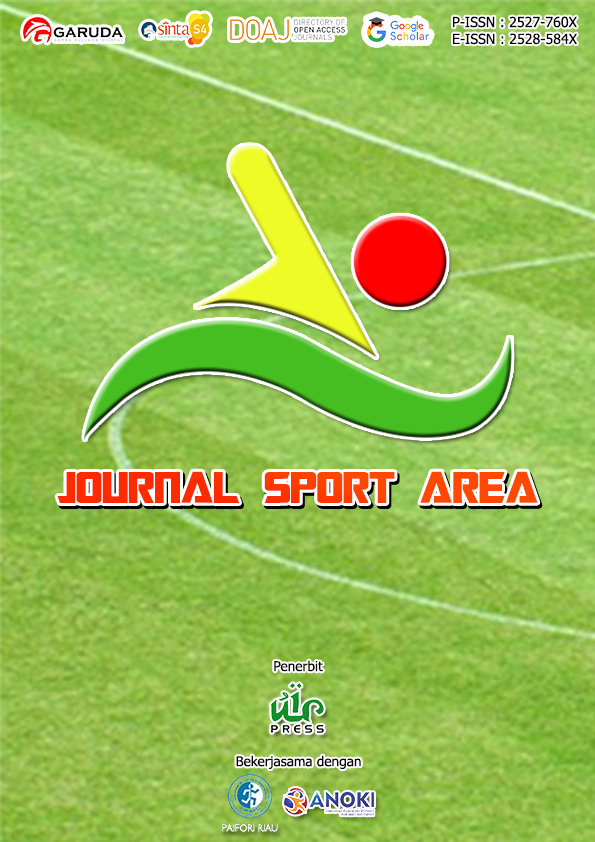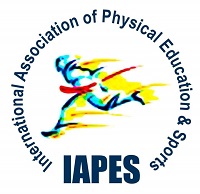Students’ evaluation in the developed video-based learning materials for physical education in Higher Education Institutions (HEIs)
Keywords:
Physical education, learning materials, video-based, rhythmic activitiesAbstract
Higher Education Institutions (HEIs) are urged to integrate technology and improve their digital skills in response to the changing overall trend and issues in the educational system. The service physical education course in college refers to four (4) topics required in the first four (4) semesters, which includes Physical Education- Rhythmic Activities. In line with this, the researcher was inspired to develop a video-based learning material for first-year students. The research study aimed to evaluate the developed learning materials by parts and characteristics. The researcher utilized the method of descriptive-evaluative research design and a self-made survey type-questionnaire was employed through an online web provider with a total of 130 students’ respondents with the used of purposive sampling. The validation and reliability of the questionnaire were also utilized and showed the 0.8284 Cronbach alpha which was good. The learning material was described by the respondents in terms of learning objective, content, and application. On the other hand, the evaluation of the learning materials in terms of usability, consistency, versatility, and aesthetic value was observed by the respondents. The findings illustrated that the overall assessment of the students’ respondents in all indicators on the Video-Based Learning Materials are highly acceptable based on their experiences while they are using the materials. This can be utilized by the 1st year students of Higher Education Institutions, revisions still consider in the development of the learning material, and validation may be done on the level of difficulty of the applications and simulations.
Downloads
References
Abd-El-Kader, N., Kottb, E. A., & Hafez, R. A. (2015). A design of physical education textbook for pupilsin the third grade of primary through modules. Ovidius University Annals, Series Physical Education & Sport/Science, Movement & Health, 15(2), 474–481.
Abuhassna, H., & Yahaya, N. (2018). Students’ utilization of distance learning through an interventional online module based on moore transactional distance theory. Eurasia Journal of Mathematics, Science and Technology Education, 14(7), 3043–3052. https://doi.org/10.29333/ejmste/91606
Afriyanti, M., Suyatna, A., & Viyanti. (2021). Design of e-modules to stimulate HOTS on static fluid materials with the STEM approach. Journal of Physics: Conference Series, 1788(1). https://doi.org/10.1088/1742-6596/1788/1/012032
Alharbi, A. (2015). A descriptive-evaluative study of a Saudi EFL textbook series. Cogent Education, 2(1), 1-26. https://doi.org/10.1080/2331186X.2015.1079946
Alonzo, O., Glasser, A., & Huenerfauth, M. (2019). Effect of automatic sign recognition performance on the usability of video-based search interfaces for sign language dictionaries. ASSETS 2019 - 21st International ACM SIGACCESS Conference on Computers and Accessibility, 56–67. https://doi.org/10.1145/3308561.3353791
Alvarez. I. (2013). High Aspirations: Transforming Dance Students from Print Consumers to Digital Producers. Journal of Interactive Media in Education, 3(2), 1-16.
Andhare, K., Dalrymple, O., & Bansal, S. (2012). Learning Objectives Feature for the Instructional Module Development System. In PSW American Society for Engineering Education Conference, San Luis Obispo, California.
Aquino, J. M. D. (2022). Management Practices and Holistic Development of Dance Troupe in Selected Secondary Schools. International Journal of Social Learning (IJSL), 2(2), 186–200. https://doi.org/10.47134/ijsl.v2i2.109
Asogwa, U. D., Ofoegbu, T. O., Eseadi, C., Ogbonna, C. S., Eskay, M., Nji, G. C., Ngwoke, O. R., Nwosumba, V. C., & Onah, B. I. (2020). The effect of a video-guided educational technology intervention on the academic self-concept of adolescent students with hearing impairment: Implications for physical education. Medicine, 99(30), e21054. https://doi.org/10.1097/MD.0000000000021054
Astalini, Darmaji, Kurniawan, W., Anwar, K., & Kurniawan, D. A. (2019). Effectiveness of using e-module and e-assessment. International Journal of Interactive Mobile Technologies, 13(9), 21–39. https://doi.org/10.3991/ijim.v13i09.11016
Carpio, C. O., & Indama, A. C. (2021). Onsite Learning and Flexible Learning Modalities: A Comparative Analysis of Students’’ Onsite Learning and Flexible Learning Modalities: A Comparative Analysis of Students’ Academic Performance. International Journal of Multidisciplinary Research and Publications Academic Performance, 4(4), 14–18.
Chertoff, E. R. (2020). Maryland Law Review Citizenship Federalism. HeinOnline, 81(2). 503.
Chorianopoulos, K., & Giannakos, M. N. (2013). Usability design for video lectures. Proceedings of the 11th European Conference on Interactive TV and Video, EuroITV 2013, 163–164. https://doi.org/10.1145/2465958.2465982
CNSC. (2019). Camarines Norte State College Citizen ’ S Charter. 2019(2018).
Culajara, C. J. (2022). Barriers to learning and performing in physical education in modular remote learning and coping strategies perceived by the students. Edu Sportivo: Indonesian Journal of Physical Education, 3(1), 11-24. https://doi.org/10.25299/es:ijope.2022.vol3(1).8559
Di-Tore, P. A., Schiavo, R., & D’Isanto, T. (2016). Physical education, motor control and motor learning: Theoretical paradigms and teaching practices from kindergarten to high school. Journal of Physical Education and Sport, 16(4), 1293–1297. https://doi.org/10.7752/jpes.2016.04205
Thanavathi, C. (2020). Digital Media in Teaching and Learning. Retrieved June 19, 2022, from https://www.researchgate.net/publication/343389768
Festiawan, R., & Khurrohman, M. F. (2021). Implementation of Higher Order Thinking Skills In Physical Education Learning In Covid-19 Era: Is It Work? COMPETITOR: Jurnal Pendidikan Kepelatihan Olahraga, 13(2), 139–153. https://doi.org/10.26858/CJPKO.V13I2.20158
Gunantar, D. A. (2017). Textbooks Analysis: Analyzing English As a Foreign Language (EFL) Textbooks From The Perspective of Indonesian Culture. Journal of Language and Literature, 11(2), 173–182.
Harsono, Y. M. (2015). Developing Learning Materials for Specific Purposes. TEFLIN Journal - A Publication on the Teaching and Learning of English, 18(2), 169. https://doi.org/10.15639/teflinjournal.v18i2/169-179
Hellison, D. (2015). Teaching Physical and Social Responsibility Through Physical Activity Just What is the System ? Physical Education and Sport Pedagogy, 83, 1–16.
Hidasari, F. P., Bafadal, M. F., & Triansyah, A. (2021). Rhythmic Activities Based on Traditional West Kalimantan Culture. 35(ICSSHT 2019), 214–218. https://doi.org/10.2991/ahsr.k.210130.045
Irfannuddin, M., Laeto, A. Bin, Zulissetiana, E. F., Santoso, B., Kurniati, A. M., & Hestiningsih, T. (2021). Virtual national workshop: preparation of multimedia modules for physical education teachers in accordance with COVID-19 prevention procedures. Advances in Physiology Education, 45(3), 563–567. https://doi.org/10.1152/ADVAN.00249.2020
Kapici, S., Sercan, C., Kulaksiz, H., Yuksel, I., & Ulucan, K. (2018). Deletion Polymorphism Profile of Turkish Professional Hip-hop and Latin dancers. Pamukkale Journal of Sport Sciences, 9(3), 49–54.
Larawan, L. (2013). Acceptability of Teacher-Made Modules in Production Management. International Journal of Managerial Studies and Research (IJMSR), 1(2), 10–22.
Lau, V. (2014). Computer-based teaching module design: principles derived from learning theories. Medical Education in Review, 48 (3), 247-254. https://doi.org/10.1111/medu.12357
López-Pastor, V. M., Kirk, D., & Lorente-catalán, E. (2013). Alternative assessment in physical education : a review of international literature. Sport, Education and Society, 18(1). 57-76. https://doi.org/10.1080/13573322.2012.713860
Macharia, J. (2013). Mobile Applications to Enhance Versatility of Mobile Learning in Higher Education. Proceedings and Reports of the 6th UbuntuNet Alliance Annual Conference, 135–144.
Ningthoujam, R., & Singh, T. I. (2014). Integration of video based analyses teaching in physical education. Health, Physical Education & Iron Games, 1(1), 230-240.
Noor, N. M., Hamizan, N. I., & Rahim, R. A. (2014). The framework for learning using video based on cognitive load theory among visual learners. 2013 IEEE 5th International Conference on Engineering Education: Aligning Engineering Education with Industrial Needs for Nation Development, ICEED 2013, 15–20. https://doi.org/10.1109/ICEED.2013.6908295
Rai, N., Alkassim, R. S., & Tran, X. (2020). A study on purposive sampling method in research. Retrieved June 19, 2022, from http://stattrek.com/survey-research/sampling-methods.aspx?Tutorial=AP,
Sasongko, N. (2018). The implementation of national standards of education for school quality improvement facing the 21st century (Descriptive evaluative studies in various levels of schools in Bengkulu province of Indonesia). International Journal of Current Research in Life Sciences, 7(8), 2647–2651.
Teychenne, M., Parker, K., Teychenne, D., Sahlqvist, S., Macfarlane, S., & Costigan, S. (2019). A pre-post evaluation of an online career planning module on university students’ career adaptability. Journal of Teaching and Learning for Graduate Employability, 10(1), 42–55. https://doi.org/10.21153/jtlge2019vol10no1art781
Vural, O. F. (2013). The Impact of a Question-Embedded Video-Based Learning Tool on E-Learning, Educational Sciences: Theory and Practice, 2013. Educational Sciences: Theory & Practice, 13(2), 1315–1323.
Weiss, J., & Jalilian, H. (2015). The University of Bradford Institutional Repository. Manufacturing as an Engine of Growth, 67(10), 26–37. https://doi.org/10.1093/bjsw/bcs140
Wong, K. H., Allen, A., & Durrani, T. S. (2019). Evaluating Effectiveness of Online Learning Modules in Pediatric Environmental Health Education. Journal of Medical Toxicology 2019 16:3, 16(3), 269–275. https://doi.org/10.1007/S13181-019-00746-7
Yuh-Tyng, C. (2012). The effect of thematic video-based instruction on learning and motivation in e-learning. International Journal of the Physical Sciences, 7(6), 957–965. https://doi.org/10.5897/ijps11.1788
Zander, C., Thomas, L., Simon, B., Murphy, L., McCauley, R., Hanks, B., & Fitzgerald, S. (2010). Learning styles: novices decide. ACM SIGCSE Bulletin, 41(3), 223–227. https://doi.org/10.1145/1562877.1562948
Published
How to Cite
Issue
Section
This is an open-access article distributed under the terms of the Creative Commons Attribution-ShareAlike 4.0 International License which permits unrestricted use, distribution, and reproduction in any medium. Users are allowed to read, download, copy, distribute, search, or link to full-text articles in this journal without asking by giving appropriate credit, provide a link to the license, and indicate if changes were made. All of the remix, transform, or build upon the material must distribute the contributions under the same license as the original.
Accepted 2022-06-19
Published 2022-07-16



.png)




















.png)







.png)





